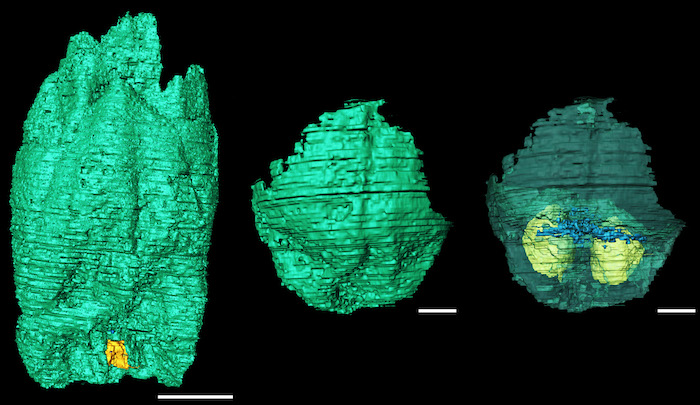Fossil Find in California Shakes Up the Natural History of Cycad Plants

LAWRENCE — Cycads, a group of gymnosperms that can resemble miniature palm trees (like the popular sago palm houseplant), were long thought to be “living fossils,” a group that had evolved minimally since the time of the dinosaurs. Now, a well-preserved 80-million-year-old pollen cone discovered in California has rewritten scientific understanding of the plants.
The findings are detailed in a paper by two University of Kansas paleobotanists just published in the journal New Phytologist.
“Cycads aren’t well-known but make up a significant part of plant diversity, accounting for around 25% of all gymnosperms,” said lead author Andres Elgorriaga, postdoctoral researcher with the KU Department of Ecology & Evolutionary Biology and KU Biodiversity Institute and Natural History Museum. “Cycads are plants that have thick stems and short stature, with thick, palm-like leaves on top. They produce cones like pine cones and are related to other seed-bearing plants that also don’t produce flowers, like Ginkgo and the monkey puzzle tree. But they’re also highly endangered, with the highest level of endangerment among all plant groups. Trafficking of cycads also is a significant issue.”
Despite their importance, a lack of fossil evidence and confusion over the years about how to classify some fossil specimens has led to a murky scientific grasp of the plants’ evolutionary history. One prominent idea was that cycads today are nearly identical to their prehistoric ancestors.
“The prevailing school of thought is that cycads did not change much in deep time,” said co-author Brian Atkinson, assistant professor of ecology & evolutionary biology and curator of paleobotany at the KU Biodiversity Institute and Natural History Museum. “But the fossil record of cycads is poorly understood, and many things that have been called cycads have turned out not to be cycads at all. Here, we have a three-dimensionally preserved cone clearly assignable to cycads because it has internal anatomy and pollen grains typical of this group. However, the external morphology of this pollen cone is different from living cycads today. This finding suggests cycads aren’t really ‘living fossils’ and they probably have a more dynamic evolutionary history than previously thought.”
According to the KU researchers, their analysis of an 80-million-year-old permineralized pollen cone found in the Campanian Holz Shale formation located in Silverado Canyon, California, tells a more accurate cycad natural history — one where the plants diversified during the Cretaceous.
“With this type of discovery, we realize during this time there were cycads that were really different than the ones today in their size, in their number of pollen sacs, in a lot of things,” Elgorriaga said. “Maybe we haven’t found that many cycad fossils as well — or maybe we’re finding them but we’re just not recognizing them because they were so different from how they are today. They aren’t ‘living fossils.’ They were different in the past.”
To perform their analysis, Elgorriaga and Atkinson studied the specimen’s cone’s architecture, anatomical details and vasculature organization using serial sectioning, scanning electron microscopy and 3D reconstruction. They also performed a series of evolutionary analyses to place the fossil within the cycad family tree.
Relying partly on the shapes of the cone’s scales, pollen and pollen sacs, they assigned the ancient plant to Skyttegaardia, a recently described genus based on isolated cone scales found in Denmark and dated to the Early Cretaceous (about 125 million years ago). Further, they erase some initial doubt about the new genus’ placement in the cycad group.
"The 3D reconstruction was striking because it only had two pollen sacs per cone scale, and the form of this cone scale reminded us of a fossil described from Scandinavia called Skyttegaardia,” Atkinson said. “There were many similarities, but the original in Scandinavia was only described in 2021 based on isolated cone scales. They cautiously explored the idea that the fossil belonged to cycad but were uncomfortable with firmly concluding this primarily because it only had two pollen sacs per cone scale — while cycads today have 20 to 700. Most cycad pollen cones are quite large, while this fossil was only half a centimeter in length.”
With the additional information from the new fossil plant, the KU researchers were “quite confident” in their phylogenetic analysis showing Skyttegaardia’s positive relationship with cycads.
The investigators said their description of the primordial plant shows how paleobotany can tell us more about how nature works through deep time.
“This shows us that the information we collect from the fossil record greatly impacts our understanding of evolutionary patterns,” Atkinson said. “Time, just like fossils, can reveal insights that aren’t apparent from studying only living plants or organisms. This case study is an excellent example of how fossils can contribute to our understanding of evolution over extended periods.”
Photo: Three-dimensional reconstruction of the whole cone and different views of the same cone scale. Scale bar: cone = 400 microns; cone scales = 200 microns. Credit: Andres Elgorriaga, Brian Atkinson